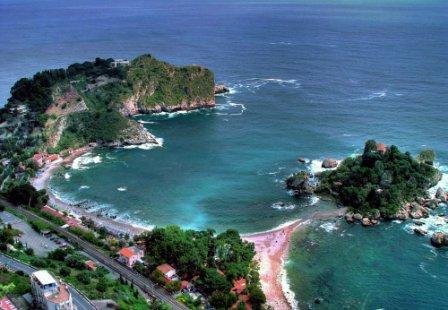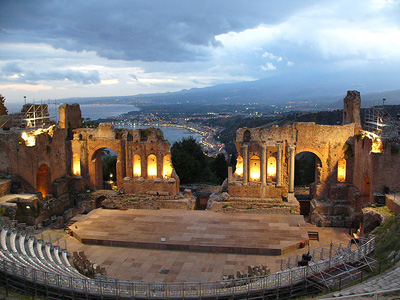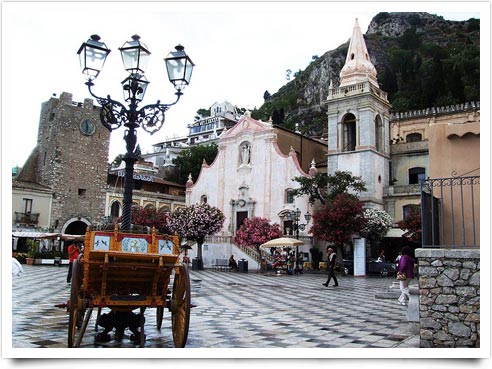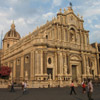Origin of the myth
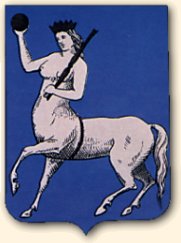 The original name of Taormina was Tauromenium – house on the Taurus mount – referred to the mountain on which it has been built. Some experts attribute the name of “Taormina” both to the Sicels and to the Greeks, even if there are a lot of legends which associate the original name of Tauromenium to some fantastic stories, such as the Minotaur one, represented in some ancient coins, or the legend of the two princes Taurus and Mena, from Palestine, who probably gave rise to the town and its name.
The original name of Taormina was Tauromenium – house on the Taurus mount – referred to the mountain on which it has been built. Some experts attribute the name of “Taormina” both to the Sicels and to the Greeks, even if there are a lot of legends which associate the original name of Tauromenium to some fantastic stories, such as the Minotaur one, represented in some ancient coins, or the legend of the two princes Taurus and Mena, from Palestine, who probably gave rise to the town and its name.
Taormina today
Unforgettable meeting point between cinema, literature and art
The tourist coming to Sicily for the first time can’t miss to visit, at least for one day, the most spectacular and panoramic terrace of the whole island, the Sicilian tourist place par excellence known and appreciated all over the world: Taormina.
Desirable set for the most famous directors, who have chosen it as a natural beauty set for their films, Taormina has always been associated to famous actors, noble people and rich families.
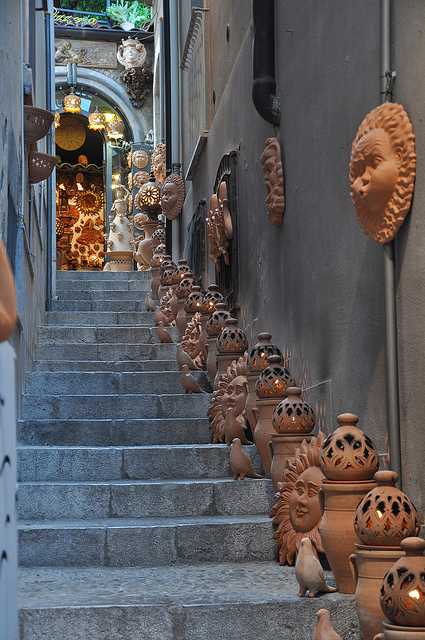
Among the well-known people who visited and stayed in Taormina, we can remember Goethe, Nietzsche, Richard Wagner, Tsar Nicola I and II, Tsarina Aleksandra Fëdorovna Romanova, Gabriele D’Annunzio, Gustav Klimt, Sigmund Freud, D. H. Lawrence, Soraya, Ava Gardner, Romy Schneider, Greta Garbo and many others.
There are many places to visit in Sicily - land of nature, culture, emotions and flavours - surely on of them is Taormina, the town of “Dolce vita” (sweet living), located about 200 m above the sea level, with its narrow alleys liven up with coloured Sicilian tambourines, handmade pottery, almond sweets and many other things of the gift shops which go from Porta Messina to Porta Catania.
During the summer Taormina becomes an exceptional stage of several cultural events such as music concerts, classical performances, operas, music, theatre and dancing season – Taormina Arte, film shows – Taormina Film Fest, Nastro d’Argento – and different other events in the breathtaking setting of the Ancient Theatre, show within the show.
To visit in Taormina
The places not to be missed for tourists

We will now start a virtual stroll among the narrow alleys and the squares of Taormina to discover this wonderful town, passing through the most particular places which make this city so extraordinary.
We can pass through Porta Messina and go on to Corso Umberto I until the beautiful square Vittorio Emanuele II.
Corvaja Palace rises on this square, an Arabian building, then there’s S. Caterina D’alessandria church, dated back to the mid-XVII century and renovated in the ‘900.
If we continue our itinerary, we can visit the ruins of Odeon, a building of the late ‘800 of Roman Empire, behind S. Caterina church.
Opposite Vittorio Emanuele II Square there’s the Congress Palace, next to the ruins of a large thermal building of the Roman period.
Taormina still keeps almost intact one of the Greek architecture masterpieces: the Greek Theatre, reachable by walking through the homonymous street.
The Greek Theatre is the second among the Sicilian classical theatres for its size, after the one of Syracuse, with its 109 m maximum diameter, built by the Greeks for the performances and then enlarged and almost fully rebuilt by the Romans, used for gladiators’ shows and finally renovated in the 80’s of the ‘900.
Another important monument build by the Romans in Sicily is the architectural complex of “Naumachie”, composed by big and small brick recesses which form a retaining wall for a huge cistern which could contain the water of the other small ones above it.
If we go ahead on Corso Umberto I, we will reach IX Aprile Square and its wonderful well-known “Belvedere” with a breathtaking landscape that goes from the white volcano Etna and the blue sea of the eastern Sicilian coast.
Another monument to visit in Taormina is S. Nicolò Cathedral, in the Cathedral Square, built in the XIII century on the ruins of a previous church, rebuilt in the XV and XVI centuries and in the eighteen century.
|
|
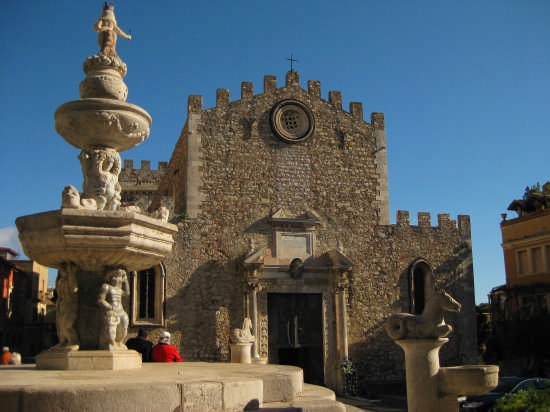 |
If you still have spare time for your trip, you could also visit:
- Floresta House, dated back to the XV and XVI centuries;
- St. Stefano Dukes’ Palace, built in the second half of the XIII century;
- The “Badia Vecchia”, also called “Badiazza”, where is located the Archaeological musem with finds dated back to the ‘800;
- Castelmola, typical small village very close to Taormina, located at the top of a chalky rock, built in the past to protect Taormina from the colonizers attacks;
- The romantic beach of “Isola Bella” (Beautiful Island), with its typical cliff fully covered by thick Mediterranean vegetation, declared “Natural Monument” by the Sicilian Region in 1984 and nature reserve in 1998.
To do in Taormina
Before leaving Taormina, be sure you have visited the internal part of the Greek Theatre and have admired the Sicilian coast landscape through the columns located at the bottom of the stage.
Don’t forget to bath in the typical beach “Isola Bella” and taste a fresh ricotta cheese “cannolo”, a citrus juice or one of the several kind of handmade water ice “granita” or one of the different local delicacies produced by the local artisans. 